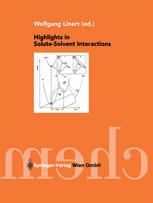

Most ebook files are in PDF format, so you can easily read them using various software such as Foxit Reader or directly on the Google Chrome browser.
Some ebook files are released by publishers in other formats such as .awz, .mobi, .epub, .fb2, etc. You may need to install specific software to read these formats on mobile/PC, such as Calibre.
Please read the tutorial at this link: https://ebookbell.com/faq
We offer FREE conversion to the popular formats you request; however, this may take some time. Therefore, right after payment, please email us, and we will try to provide the service as quickly as possible.
For some exceptional file formats or broken links (if any), please refrain from opening any disputes. Instead, email us first, and we will try to assist within a maximum of 6 hours.
EbookBell Team

0.0
0 reviewsMost organic molecules retain their integrity when dissolved, and even though in such cases the effects exerted by solvents are, in the language of the coordination chemist, of the "outer sphere" kind, the choice of solvent can be critical to the successful outcome of an operation or preparation. Solubilities of reactants and products must be taken into account, and even if the organic principals in the reactions retain their integrity, many of the reagents are electrolytes, and their state of aggregation will affect their reactivity. In testifying to the importance of understanding solute-solvent interactions I draw attention to a large class of inorganic species for which the involvement in the chemical and physical properties by the solvent is even more deeply seated. It is comprised by the large body of metal atoms in low oxidation states for which solvent molecules intervene as reagents. At the same time, because the ions carry charges, the effects arising from outer sphere interactions are usually greater than they are for neutral molecules. To cite an example: when FeCb(s) is dissolved in water to form a dilute - say O. OlO- solution there is a complete reorganization of the coordination sphere of the cation. Whereas in the solid each cation is surrounded by six chloride ions, in the solution the dominant form is [Fe(H20)6]3+ followed by [Fe(H20)sCI]2+, [Fe(H20)4CI2]+, etc. in rapidly decreasing abundance.